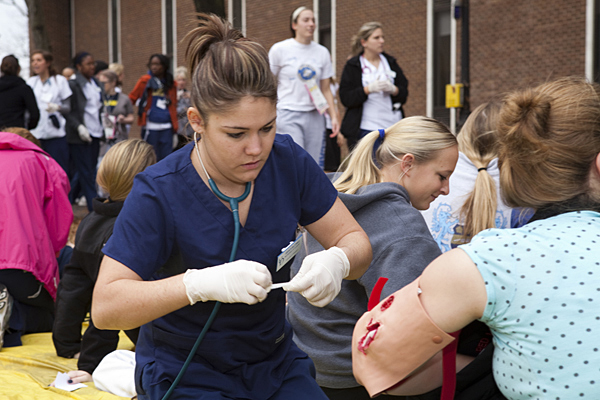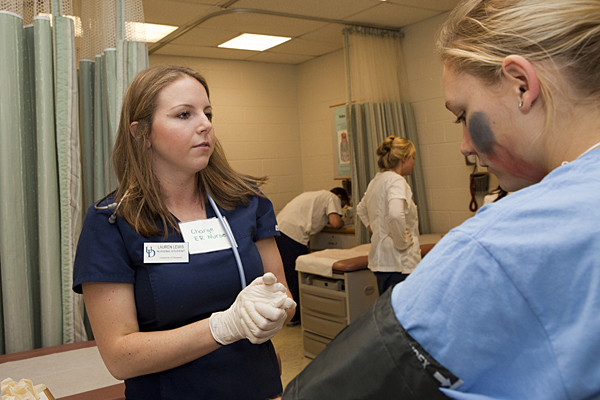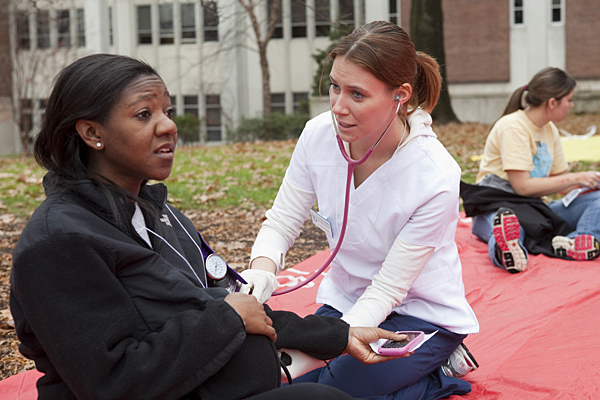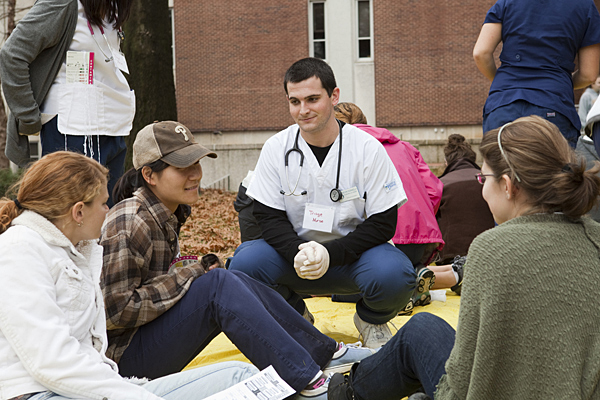


Trauma and triage
Students learn to deal with injuries, emotional trauma associated with disaster
9:09 a.m., Nov. 30, 2011--“Don’t help me, help my baby,” the distraught young woman sobs. “Please tell me now—is he going to die?”
She drops to her knees as a nurse gently takes the infant from her and carries him toward the makeshift morgue on the grass. “Where are you taking my baby?” she screams. “No, bring him back. I need my baby….”
Campus Stories
From graduates, faculty
Doctoral hooding
The disaster scene is chillingly realistic, with health care professionals rushing to help the injured, people screaming in pain and fear, and a triage area set up on the outskirts of the site. But it’s not real—it’s a simulation on the University of Delaware campus.
The drills are held by the School of Nursing (SON) twice a year to prepare students for large-scale disasters with mass casualties. The most-recent scenario, staged on Monday, Nov. 21, was a sports arena roof collapse. Past episodes have included a school shooting and an explosion in a campus student center.
“This is not about giving CPR,” says Prof. Bethany Hall-Long. “This is about mass casualty and all hazards preparation to teach our students how to coordinate efforts and triage people from one system to the next.”
To help make the drills even more realistic, faculty in the SON began to consult with UD’s internationally renowned Disaster Research Center last year. This year, graduate students from the School of Public Policy and Administration’s Disaster Science and Management Program observed the exercise in order to provide constructive feedback to the drill participants.
“Our students are primarily involved in the communication and coordination aspects of a disaster like this,” says Jim Kendra, DRC director and associate professor in the School of Public Policy and Administration. “They’re looking at how the medical professionals communicate with each other and how they distribute information.”
The nursing students quickly learn that handling a disaster is about much more than assessing and treating physical injuries. The young mother whose infant has died is relentless—she alternates between begging the nurses to help the baby and accusing them of placing other victims’ needs over hers.
“These are important lessons for our students,” says Amy Cowperthwait, resource simulation center coordinator in the SON, “and a drill like this can help them develop the skills they need to deal appropriately with people who are frantically trying to get help and find lost loved ones.”
“We’ve actually had prospective students express an interest in attending UD based on the fact that we do these disaster drills,” she adds.
The value of the drills was recently brought home to Cowperthwait when she received the following email from a student: "I just wanted to tell you how much the disaster drill you put together last semester helped me this summer. I worked in the ER of Bellevue Hospital in NYC, and when our disaster phone rang the day the steam pipe exploded, it was a complete panic. I really felt prepared because of the drill, and I was able to understand what was going on when all the people came in with the tags around their necks and the whole disaster procedure. I was thrown in a Hazmat suit, and I helped shower the people covered in asbestos. The way the ER ran that day was very similar to the drill we ran last spring, and I just wanted to thank you and let you know that because I found it very useful."
About disaster-related collaborations at UD
The UD School of Nursing is currently working with the Delaware Division of Long Term Care Residents Protection (DLTCRP) on disaster preparedness for long-term health care facilities.
Faculty in the SON also routinely partner with public health nurses on disaster training.
UD’s Disaster Research Center is widely recognized as a pioneering institution in human behavioral and social scientific issues associated with disaster. DRC has a portfolio of more than 600 field studies in the aftermath of disasters, catastrophes and community crises, and the center’s faculty members are commonly called upon by local, national and international governments as well as the news media for consultation and commentary on critical contemporary events and issues related to disasters and emergency management.
Master’s and doctoral degrees are offered through UD’s interdisciplinary Disaster Science and Management Program.
Article by Diane Kukich
Photos by Ambre Alexander











